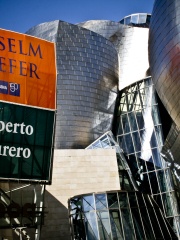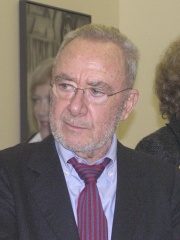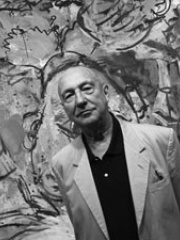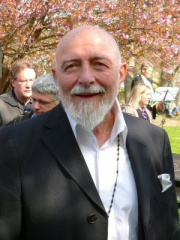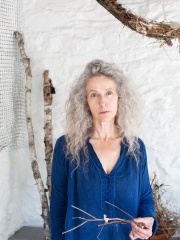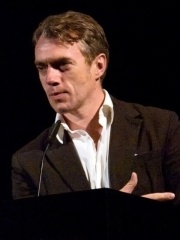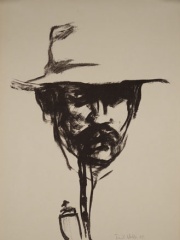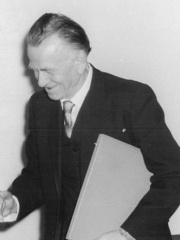
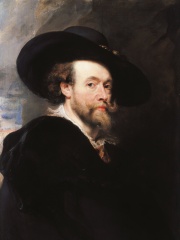

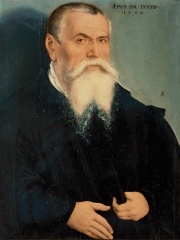
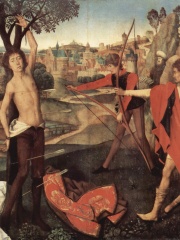
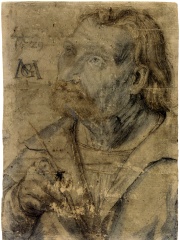
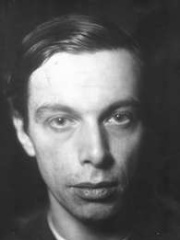
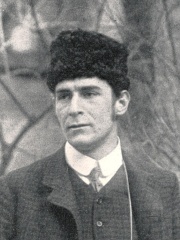
The Most Famous
PAINTERS from Germany
This page contains a list of the greatest German Painters. The pantheon dataset contains 2,023 Painters, 160 of which were born in Germany. This makes Germany the birth place of the 4th most number of Painters behind France, and United States.
Top 10
The following people are considered by Pantheon to be the top 10 most legendary German Painters of all time. This list of famous German Painters is sorted by HPI (Historical Popularity Index), a metric that aggregates information on a biography's online popularity. Visit the rankings page to view the entire list of German Painters.

1. Albrecht Dürer (1471 - 1528)
With an HPI of 89.52, Albrecht Dürer is the most famous German Painter. His biography has been translated into 158 different languages on wikipedia.
Albrecht Dürer ( DURE-ər, German: [ˈalbʁɛçt ˈdyːʁɐ]; 21 May 1471 – 6 April 1528), sometimes spelled in English as Durer or Duerer, was a German painter, printmaker, and theorist of the German Renaissance. Born in Nuremberg, Dürer established his reputation and influence across Europe in his twenties due to his high-quality woodcut prints. He was in contact with the major Italian artists of his time, including Raphael, Giovanni Bellini and Leonardo da Vinci, and from 1512 was patronized by Emperor Maximilian I. Dürer's vast body of work includes engravings, his preferred technique in his later prints, altarpieces, portraits and self-portraits, watercolours and books. The woodcuts series are stylistically more Gothic than the rest of his work, but revolutionised the potential of that medium, while his extraordinary handling of the burin expanded especially the tonal range of his engravings. Dürer's introduction of classical motifs and of the nude into Northern art, through his knowledge of Italian artists and German humanists, has secured his reputation as one of the most important figures of the Northern Renaissance. This is reinforced by his theoretical treatises, which involve principles of mathematics for linear perspective and body proportions.

2. Peter Paul Rubens (1577 - 1640)
With an HPI of 88.29, Peter Paul Rubens is the 2nd most famous German Painter. His biography has been translated into 150 different languages.
Sir Peter Paul Rubens ( ROO-bənz; Dutch: [ˈpeːtər pʌul ˈrybəns]; 28 June 1577 – 30 May 1640) was a Flemish artist and diplomat. He is considered the most influential artist of the Flemish Baroque tradition. Rubens's highly charged compositions reference erudite aspects of classical and Christian history. His unique and immensely popular Baroque style emphasised movement, colour, and sensuality, which followed the immediate, dramatic artistic style promoted in the Counter-Reformation. Rubens was a painter producing altarpieces, portraits, landscapes, and history paintings of mythological and allegorical subjects. He was also a prolific designer of cartoons for the Flemish tapestry workshops and of frontispieces for the publishers in Antwerp. Rubens was born and raised in the Holy Roman Empire (modern-day Germany) to parents who were refugees from Antwerp in the Duchy of Brabant in the Southern Netherlands (modern-day Belgium) and moved to Antwerp at about 12. In addition to running a large workshop in Antwerp that produced paintings popular with nobility and art collectors throughout Europe, Rubens was a classically educated humanist scholar and diplomat who was knighted by both Philip IV of Spain and Charles I of England. Rubens was a prolific artist. The catalogue of his works by Michael Jaffé lists 1,403 pieces, excluding numerous copies made in his workshop. His commissioned works were mostly history paintings, which included religious and mythological subjects, and hunt scenes. He painted portraits, especially of friends, and self-portraits, and in later life painted several landscapes. Rubens designed tapestries and prints, as well as his own house. He also oversaw the ephemeral decorations of the royal entry into Antwerp by the Cardinal-Infante Ferdinand of Austria in 1635. He wrote a book with illustrations of the palaces in Genoa, which was published in 1622 as Palazzi di Genova. The book was influential in spreading the Genoese palace style in Northern Europe. Rubens was an avid art collector and had one of the largest collections of art and books in Antwerp. He was also an art dealer and is known to have sold important art objects to George Villiers, 1st Duke of Buckingham. He was one of the last major artists to make consistent use of wooden panels as a support medium, even for very large works, but used canvas as well, especially when the work needed to be sent a long distance. For altarpieces, he sometimes painted on slate to reduce reflection problems.

3. Caspar David Friedrich (1774 - 1840)
With an HPI of 80.37, Caspar David Friedrich is the 3rd most famous German Painter. His biography has been translated into 76 different languages.
Caspar David Friedrich (German: [ˌkaspaʁ ˌdaːvɪt ˈfʁiːdʁɪç] ; 5 September 1774 – 7 May 1840) was a German Romantic landscape painter, generally considered the most important German artist of his generation, whose often symbolic, and anti-classical work, conveys a subjective, emotional response to the natural world. Friedrich's paintings often set contemplative human figures silhouetted against night skies, morning mists, barren trees or Gothic ruins. Art historian Christopher John Murray described their presence, in diminished perspective, amid expansive landscapes, as reducing the figures to a scale that directs "the viewer's gaze towards their metaphysical dimension". Friedrich was born in the town of Greifswald on the Baltic Sea in what was at the time Swedish Pomerania. He studied in Copenhagen 1794–1798, before settling in Dresden. He came of age during a period when, across Europe, a growing disillusionment with materialistic society was giving rise to a new appreciation of spirituality. This shift was often expressed through a reevaluation of the natural world, as artists such as Friedrich, J. M. W. Turner and John Constable sought to depict nature as a "divine creation, to be set against the artifice of human civilization". Friedrich's work brought him renown early in his career. Contemporaries such as the French sculptor David d'Angers spoke of him as having discovered "the tragedy of landscape". His work nevertheless fell from favour during his later years, and he died in obscurity. As Germany moved towards modernisation in the late 19th century, a new sense of urgency characterised its art, and Friedrich's contemplative depictions of stillness came to be seen as products of a bygone age. The early 20th century brought a renewed appreciation of his art, beginning in 1906 with an exhibition of thirty-two of his paintings in Berlin. His work influenced Expressionist artists and later Surrealists and Existentialists. The rise of Nazism in the early 1930s saw a resurgence in Friedrich's popularity, but this was followed by a sharp decline as his paintings were, by association with the Nazi movement, seen as promoting German nationalism. Since the 1970s, Friedrich has experienced a major international revival and is regarded as one of the most important artists of German Romanticism and a national cultural icon.

4. Lucas Cranach the Elder (1472 - 1553)
With an HPI of 78.79, Lucas Cranach the Elder is the 4th most famous German Painter. His biography has been translated into 57 different languages.
Lucas Cranach the Elder (German: Lucas Cranach der Ältere [ˈluːkas ˈkʁaːnax deːɐ̯ ˈʔɛltəʁə]; c. 1472 – 16 October 1553) was a German Renaissance painter and printmaker in woodcut and engraving. He was court painter to the Electors of Saxony for most of his career, and is known for his portraits, both of German princes and leaders of the Protestant Reformation, whose cause he embraced with enthusiasm. He was a close friend of Martin Luther, and eleven portraits of that reformer by him survive. Cranach also painted religious subjects, first in the Catholic tradition, and later trying to find new ways of conveying Lutheran religious concerns in art. He continued to paint nude subjects from mythology and religion throughout his career. Cranach had a large workshop and many of his works exist in different versions; his son Lucas Cranach the Younger and others continued to create versions of his father's works for decades after his death. He has been considered the most successful German artist of his time.
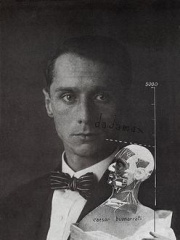
5. Max Ernst (1891 - 1976)
With an HPI of 77.62, Max Ernst is the 5th most famous German Painter. His biography has been translated into 63 different languages.
Max Ernst (; German: [ɛʁnst] 2 April 1891 – 1 April 1976) was a German-born painter, sculptor, printmaker, graphic artist, and poet. A prolific artist, Ernst was a primary pioneer of the Dada movement and surrealism in Europe. He had no formal artistic training, but his experimental attitude toward the making of art resulted in his invention of frottage—a technique that uses pencil rubbings of textured objects and relief surfaces to create images—and grattage, an analogous technique in which paint is scraped across canvas to reveal the imprints of the objects placed beneath. Ernst is noted for his unconventional drawing methods as well as for creating novels and pamphlets using the method of collages. He served as a soldier for four years during World War I, and this experience left him shocked, traumatised and critical of the modern world. During World War II he was designated an "undesirable foreigner" while living in France. Ernst was born in Brühl. He began painting in 1909 while studying at the University of Bonn, and later joined the Die Rheinischen Expressionisten group of artists. Ernst's work often featured ironic juxtapositions of grotesque elements with cubist and expressionist motifs. He had a fascination with birds, often including his alter ego, Loplop, a bird, in his work. He eventually settled in France and achieved financial success in the 1950s. He died in Paris on 1 April 1976.

6. Hans Memling (1435 - 1494)
With an HPI of 76.26, Hans Memling is the 6th most famous German Painter. His biography has been translated into 50 different languages.
Hans Memling (also spelled Memlinc; c. 1430 – 11 August 1494) was a German-Flemish painter who worked in the tradition of Early Netherlandish painting. Born in the Middle Rhine region, he probably spent his childhood in Mainz. During his apprenticeship as a painter he moved to the Netherlands and spent time in the Brussels workshop of Rogier van der Weyden. In 1465 he was made a citizen of Bruges, where he became one of the leading artists and the master of a large workshop. A tax document from 1480 lists him among the wealthiest citizens. Memling's religious works often incorporated donor portraits of the clergymen, aristocrats, and burghers (bankers, merchants, and politicians) who were his patrons. These portraits built upon the styles which Memling learned in his youth. He married Anna de Valkenaere sometime between 1470 and 1480, and they had three children. Memling's art was rediscovered in the 19th century, attaining wide popularity.

7. Matthias Grünewald (1480 - 1528)
With an HPI of 76.21, Matthias Grünewald is the 7th most famous German Painter. His biography has been translated into 48 different languages.
Matthias Grünewald (c. 1470 – 31 August 1528; also known as Mathis Gothart Nithart) was a German Renaissance painter of religious works who ignored Renaissance classicism to continue the style of late medieval Central European art into the 16th century. Only ten paintings—including several polyptychs—and thirty-five drawings survive, all religious, although many others were lost at sea on their way to Sweden as war booty. He was obscure until the late nineteenth century, when many of his paintings were attributed to Albrecht Dürer, who is now seen as his stylistic antithesis. His largest and most famous work is the Isenheim Altarpiece created c. 1512 to 1516.

8. Ernst Ludwig Kirchner (1880 - 1938)
With an HPI of 75.30, Ernst Ludwig Kirchner is the 8th most famous German Painter. His biography has been translated into 58 different languages.
Ernst Ludwig Kirchner (6 May 1880 – 15 June 1938) was a German expressionist painter and printmaker. He was one of the founders of the artists group Die Brücke or "The Bridge", a key group leading to the foundation of Expressionism in 20th-century art. Kirchner volunteered for army service in the First World War, but soon suffered a breakdown and was discharged. His work was branded as "degenerate" by the Nazis in 1933, and in 1937 more than 600 of his works were sold or destroyed.

9. Franz Marc (1880 - 1916)
With an HPI of 75.00, Franz Marc is the 9th most famous German Painter. His biography has been translated into 60 different languages.
Franz Moritz Wilhelm Marc (8 February 1880 – 4 March 1916) was a German painter and printmaker, one of the key figures of German Expressionism. He was a founding member of Der Blaue Reiter (The Blue Rider), a journal whose name later became synonymous with the circle of artists collaborating in it. His mature works mostly are animals, and are known for bright colors. He was drafted to serve in the German Army at the beginning of World War I, and died two years later at the Battle of Verdun. In the 1930s, the Nazis named him a degenerate artist as part of their suppression of modern art. However, most of his work survived World War II, securing his legacy. His work is now exhibited in many eminent galleries and museums. His major paintings have attracted large sums, with a record of £42,654,500 for Die Füchse (The Foxes) in 2022.

10. Albrecht Altdorfer (1480 - 1538)
With an HPI of 74.90, Albrecht Altdorfer is the 10th most famous German Painter. His biography has been translated into 50 different languages.
Albrecht Altdorfer (c. 1480 – 12 February 1538) was a German painter, engraver and architect of the Renaissance working in Regensburg, Bavaria. Along with Lucas Cranach the Elder and Wolf Huber he is regarded to be the main representative of the Danube School, setting biblical and historical subjects against landscape backgrounds of expressive colours. He is remarkable as one of the first artists to take an interest in landscape as an independent subject. As an artist also making small intricate engravings he is seen to belong to the Nuremberg Little Masters.
People
Pantheon has 160 people classified as German painters born between 1380 and 1960. Of these 160, 7 (4.38%) of them are still alive today. The most famous living German painters include Anselm Kiefer, Gerhard Richter, and Georg Baselitz. The most famous deceased German painters include Albrecht Dürer, Peter Paul Rubens, and Caspar David Friedrich.
Living German Painters
Go to all RankingsAnselm Kiefer
1945 - Present
HPI: 72.93
Gerhard Richter
1932 - Present
HPI: 72.32
Georg Baselitz
1938 - Present
HPI: 67.68
Christiane Kubrick
1932 - Present
HPI: 60.28
Markus Lüpertz
1941 - Present
HPI: 56.42
Kiki Smith
1954 - Present
HPI: 54.99
Neo Rauch
1960 - Present
HPI: 53.11
Deceased German Painters
Go to all RankingsAlbrecht Dürer
1471 - 1528
HPI: 89.52
Peter Paul Rubens
1577 - 1640
HPI: 88.29
Caspar David Friedrich
1774 - 1840
HPI: 80.37
Lucas Cranach the Elder
1472 - 1553
HPI: 78.79
Max Ernst
1891 - 1976
HPI: 77.62
Hans Memling
1435 - 1494
HPI: 76.26
Matthias Grünewald
1480 - 1528
HPI: 76.21
Ernst Ludwig Kirchner
1880 - 1938
HPI: 75.30
Franz Marc
1880 - 1916
HPI: 75.00
Albrecht Altdorfer
1480 - 1538
HPI: 74.90
Emil Nolde
1867 - 1956
HPI: 73.18
Otto Dix
1891 - 1969
HPI: 73.15
Overlapping Lives
Which Painters were alive at the same time? This visualization shows the lifespans of the 25 most globally memorable Painters since 1700.

